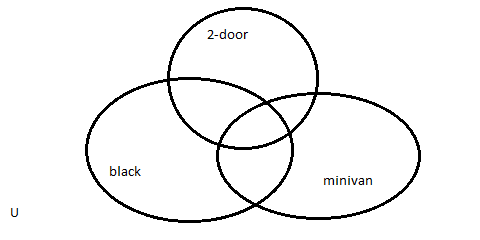
| Problem Statement | |
| Yesterday, in parking lot 1 at WCC, there were 239 vehicles. Of those, there were 60 two-door vehicles, 47 black vehicles, and 64 minivans. In addition, there were 9 vehicles that were two-door, black, and minivans, while there were 18 two-door black vehicles and 30 minivans that are neither two-door nor black. Finally, there were a total of 26 two-door minivans. | |
| 9. | How many black minivans were in the lot? |
| 10. | How many black vehicles that are neither two-door nor minivans were in the lot? |
| 11. | How many vehicles are neither two-door nor black? |
We start with a Venn Diagram of the relationship between the three groups: 2-door, black, and minivan vehicles. Note that the entire rectanlge represents the the Universal Set, in this cas all vehicles in parking lot #1 at WCC yesterday.

To this we will add some small notations telling us how many vehicles are in each major group. In addition, in Figure 2, we note that the Universal set has 239 vehicles in it.
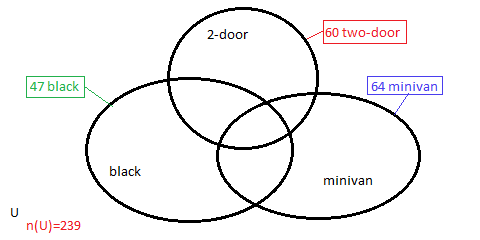
The statement in the problem "there were 9 vehicles that were two-door, black, and minivans" refers to the region highlighted in Figure 3. That is the region of vehicles that are 2-door, black, and minivan.
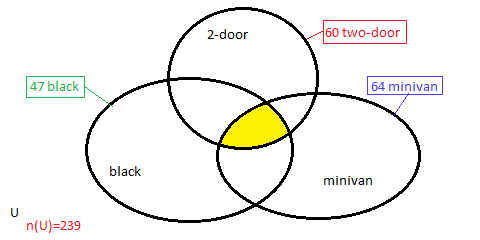
From the problem statement we can write a 9 in that region because we know that there are 9 vehicles in that specific region. That change is shown in Figure 4.
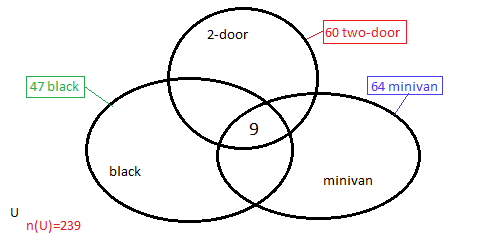
Next, we consider the problem statement "there were 18 two-door black vehicles". The region associated with "two-door black vehicles" is highlighted in Figure 5.
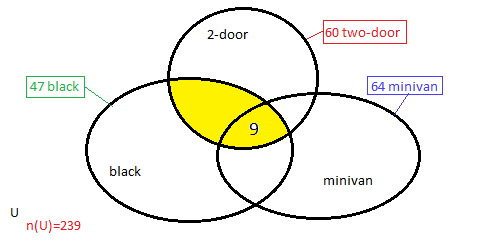
We know that there ae 9 vehicles in part of the region, but how many are in the other part? Since there are 18 vehices in the entire shaded region of Figure 5, there must be 9 vehicles in the other part of that region. In Figure 6 we fill in the result with a 9.
The next part of the problem statement, "30 minivans that are neither two-door nor black" refers to the area highlighted in Figure 6.
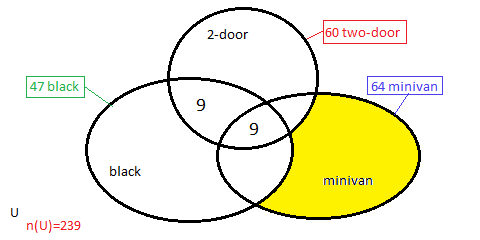
The statement saind that there were 30 vehicles in the shaded area of Figure 6, so, in Figure 7 we put 30 into that region.
The concluding information in the problem statement, "there were a total of 26 two-door minivans", refers to the highighted regon in Figure 7.
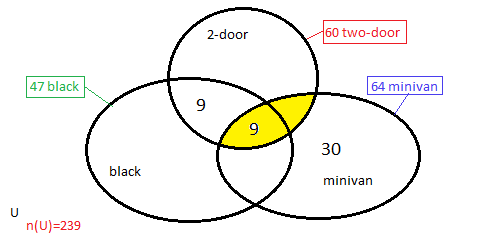
As before, we know that part of the highlighted region in Figure 7 has 9 vehicles in it, so the remaining part must have 17 vehicles in order for the entire shaded area to have 26 vehicles in it. We place the 17 into the open area as shown in Figure 8.
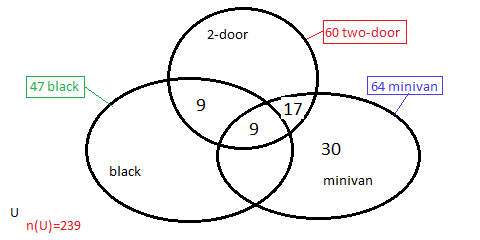
Now, with no more informaiton from the problem statement, we look at the region devoted to minivans. The shaded region in Figure 9 is the only part of the minivan region where we do not know the number of vehicles in the region.
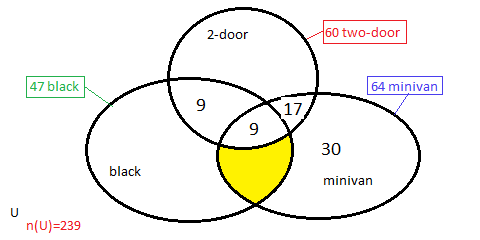
However, we know that there are a total of 64 minivan vehicles. We see that we already know the location of 9+17+30 of them (that is 56 of them). Therefore, the remaining 8 must be in the region shaded in Figure 9. We place the 8 in that region as shown in Figure 10.
Then we turn our attention to the region evoted to black vehicles. The only part of that region for which we do not know the size is highighted in Figure 10.
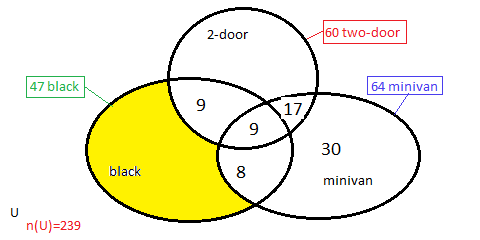
However, we do know that there are 47 black vehicles, and since we already know the region assoiated with 9+9+8 of them (i.e., 26 of them), the remaining black 21 black vehcles must be in that highlighted area. Therefore, in Figure 11we have inserrted the 21 into that region.
That leaves the one part of the 2-door vehicle region as having an unkown size. Figure 11 has that region highlighted.
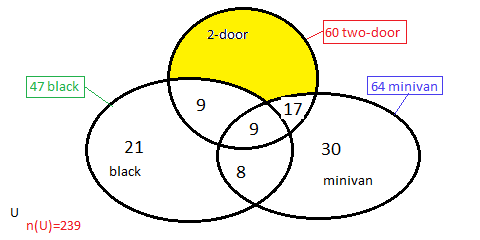
But we do know that there are 60 two door vehicles. We see where 9+9+17 (or 35) of them have been assigned. That just leaves 25 to assign to the shaded region of Figure 11. We have made that assignment in Figure 12.
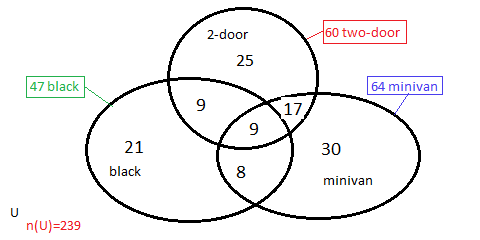
Now that we have figured out the size of each region, we can start to answer the questions.
How many black minivans were in the lot? Figure 13 has highlighted that region. It is clear that there are 8+9 vehicles in the highlighted regions. Therefore, the answer is 17.
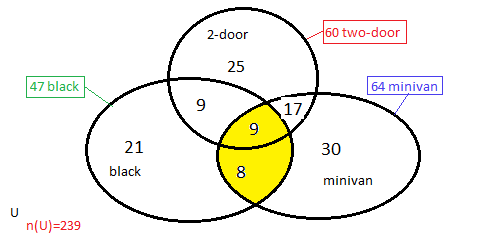
How many black vehicles that are neither two-door nor minivans were in the lot? Figure 14 has highlighted that region. It is clear that there are 21 vehicles in the highlighted regions. Therefore, the answer is 21.
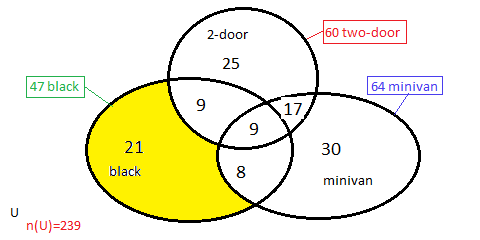
How many vehicles are neither two-door nor black? The way the question is phrased we must be looking at the entire shaded region of Figure 15. Of course, we know that there are 239 vehicles in the entire rectangular region. We also know that there are 60 vehiles in the 2-door region. That 2-door region makes up a large portion of the unshaded area. All we are missing of the unshaded portion is two pieces of the black vehicle region, the ones holding 21 and 8 vehicles. Therefore, the number of vehicles in the unshaded portion of Figure 15 is 60+21+8 or 89 vehicles. The total of the shaded portion must be 239-89, or 150. Therefore, the answer is 150.
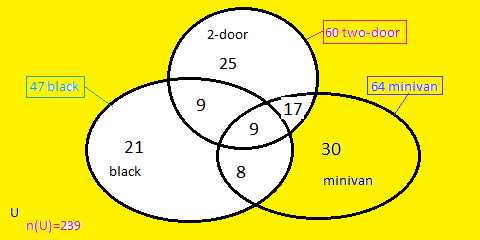
©Roger M. Palay
Saline, MI 48176 October, 2015